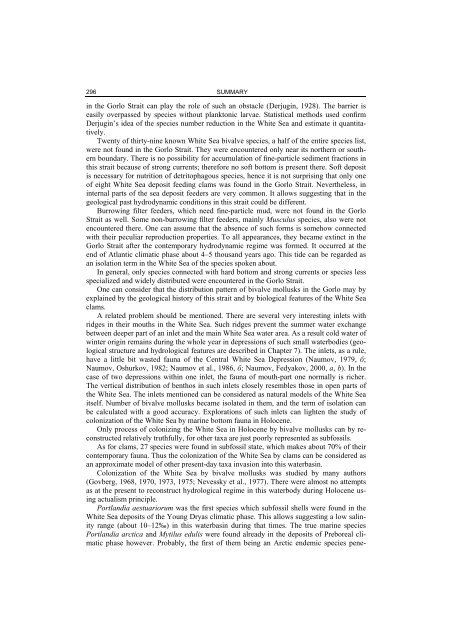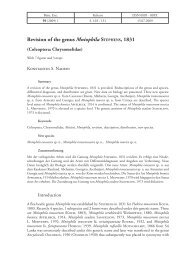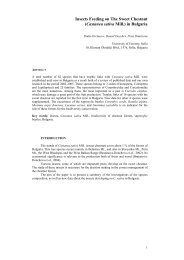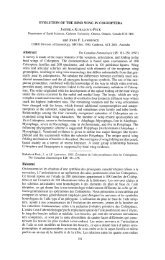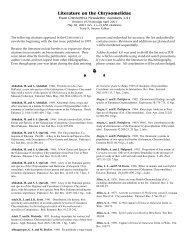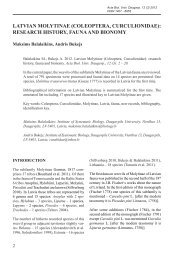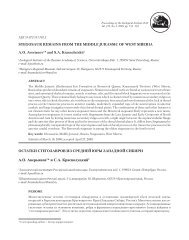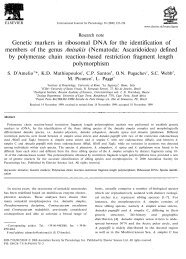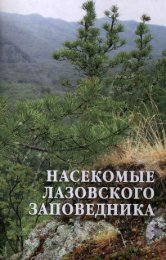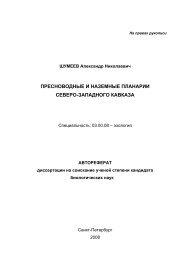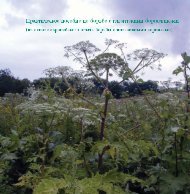SUMMARY 2953) Species which can withstand a short rise of temperature up to 20°C or even higher.It should be stressed, however, that even the most cold-water species of Arctic origin,e. g., Portlandia arctica, can withstand considerable rise of temperature if it does not continuefor too long of a period.It is well known that the maximum species number is associated in seas with the normaloceanic salinity about 35‰ (Chlebovich, 1962, 1974; Kinne, 1971). Whereas, the total speciesnumber decreases in areas of high salinity in the White Sea in many taxa (Berger et al.,1995). This holds true for bivalve mollusks (Fig. 82). This fact prima facie looks surprising.However, reduction of the total species number under high salinity conditions in the WhiteSea clams can be easily explained by their temperature and edaphic relations.There are not so many clam species in the White Sea which need constant negativetemperature. Such conditions take place in a single biotope – in the Central White Sea Depressionat the depth over 100 m. Similar biotopes with high salinity and temperature closeto 0ºC can be encountered in some cold-water inlets with ridges in their mouths. The seabottom, both in Central Depression and in deeper parts of such inlets, is covered with verythin silt. All these biotopes are inhabited by soft bottom fauna of Arctic origin. Less diverseedaphic conditions lead to small species number in cold-water biotopes, which only arefilled with water of high salinity (Naumov, 1979, б; Naumov, Oshurkov, 1982; Naumov eta., 1986б; Naumov, Fedyakov, 2000, a, b). Species numbers grow versus salinity increasingin Arctic-boreal and Arctic components investigated separately in the White Sea fauna(Fig. 84).Hence, the suggestion of the dualistic nature of the White Sea bivalve mollusks faunaproves to be true. One part of this fauna has boreal and Arctic-boreal origin, while the secondpart – an Arctic one. As a result, the whole sea can be defined as an intermediate onebetween the Northern Atlantic and the Arctic Ocean (Fedyakov, Naumov, 1987; Naumov,Fedyakov, 1989). It is expressed in a peculiar species composition, in deposit feeder tofilter feeder ratio (Naumov, Fedyakov, 1990, 1994) and in the relationship of species numberagainst salinity (Berger et al., 1995).Investigations of a regional distribution of clam species in the White Sea showed five ofits main variants which can be preliminary referred as local distribution areas.Bivalve mollusks of the first local distribution area type are found mainly in the GorloStrait, at the shallows along the Tersky, Kandalaksha and Karelia Shores, and in the northernpart of the Onega Bay (Fig. 80, Б)Bivalve mollusks of the second local distribution area type are found mainly at the shallowsalong the Tersky, Kandalaksha and Karelia Shores, in the northern part of the OnegaBay, and in the Dvina Bay (Fig. 80, В).The third local distribution area type includes all the shallows except the Gorlo Strait(Fig. 80, Г).The fourth local distribution area type embraces practically the entire sea except theGorlo Strait, the Mezen’ Bay, and southern part of the Onega Bay (Fig. 80, Д).The fifth local distribution area type covers the whole White Sea (Fig. 80, Е).It should be stressed that species without pelagic larvae are spread more widely in theWhite Sea. It emphasizes the Arctic visage of this waterbasin according Thorson’s principle(Thorson, 1936) once more.It has been shown earlier (Gontar, Naumov, 1994; Naumov, Gontar, 2004) that thespreading of bottom fauna along the shelf of Arctic seas during Holocene satisfactorily fitsPiccoli–Sartori–Francino model (Piccoli et al., 1986). In spite of it, there are two times lessbivalve species in the White Sea than theoretically estimated. The species deficiency insome taxa inhabited the White Sea is a well known fact, which is commonly referred asnegative faunistic features (Derjugin, 1928). Thus, a kind of barrier can be assumed on theway of colonization of this basin by bivalve mollusks. The isolating hydrodynamic regime
296SUMMARYin the Gorlo Strait can play the role of such an obstacle (Derjugin, 1928). The barrier iseasily overpassed by species without planktonic larvae. Statistical methods used confirmDerjugin’s idea of the species number reduction in the White Sea and estimate it quantitatively.Twenty of thirty-nine known White Sea bivalve species, a half of the entire species list,were not found in the Gorlo Strait. They were encountered only near its northern or southernboundary. There is no possibility for accumulation of fine-particle sediment fractions inthis strait because of strong currents; therefore no soft bottom is present there. Soft depositis necessary for nutrition of detritophagous species, hence it is not surprising that only oneof eight White Sea deposit feeding clams was found in the Gorlo Strait. Nevertheless, ininternal parts of the sea deposit feeders are very common. It allows suggesting that in thegeological past hydrodynamic conditions in this strait could be different.Burrowing filter feeders, which need fine-particle mud, were not found in the GorloStrait as well. Some non-burrowing filter feeders, mainly Musculus species, also were notencountered there. One can assume that the absence of such forms is somehow connectedwith their peculiar reproduction properties. To all appearances, they became extinct in theGorlo Strait after the contemporary hydrodynamic regime was formed. It occurred at theend of Atlantic climatic phase about 4–5 thousand years ago. This tide can be regarded asan isolation term in the White Sea of the species spoken about.In general, only species connected with hard bottom and strong currents or species lessspecialized and widely distributed were encountered in the Gorlo Strait.One can consider that the distribution pattern of bivalve mollusks in the Gorlo may byexplained by the geological history of this strait and by biological features of the White Seaclams.A related problem should be mentioned. There are several very interesting inlets withridges in their mouths in the White Sea. Such ridges prevent the summer water exchangebetween deeper part of an inlet and the main White Sea water area. As a result cold water ofwinter origin remains during the whole year in depressions of such small waterbodies (geologicalstructure and hydrological features are described in Chapter 7). The inlets, as a rule,have a little bit wasted fauna of the Central White Sea Depression (Naumov, 1979, б;Naumov, Oshurkov, 1982; Naumov et al., 1986, б; Naumov, Fedyakov, 2000, a, b). In thecase of two depressions within one inlet, the fauna of mouth-part one normally is richer.The vertical distribution of benthos in such inlets closely resembles those in open parts ofthe White Sea. The inlets mentioned can be considered as natural models of the White Seaitself. Number of bivalve mollusks became isolated in them, and the term of isolation canbe calculated with a good accuracy. Explorations of such inlets can lighten the study ofcolonization of the White Sea by marine bottom fauna in Holocene.Only process of colonizing the White Sea in Holocene by bivalve mollusks can by reconstructedrelatively truthfully, for other taxa are just poorly represented as subfossils.As for clams, 27 species were found in subfossil state, which makes about 70% of theircontemporary fauna. Thus the colonization of the White Sea by clams can be considered asan approximate model of other present-day taxa invasion into this waterbasin.Colonization of the White Sea by bivalve mollusks was studied by many authors(Govberg, 1968, 1970, 1973, 1975; Nevessky et al., 1977). There were almost no attemptsas at the present to reconstruct hydrological regime in this waterbody during Holocene usingactualism principle.Portlandia aestuariorum was the first species which subfossil shells were found in theWhite Sea deposits of the Young Dryas climatic phase. This allows suggesting a low salinityrange (about 10–12‰) in this waterbasin during that times. The true marine speciesPortlandia arctica and Mytilus edulis were found already in the deposits of Preboreal climaticphase however. Probably, the first of them being an Arctic endemic species pene-
- Page 2 and 3:
êéëëàâëäÄü ÄäÄÑÖåà
- Page 4 and 5:
êéëëàâëäÄü ÄäÄÑÖåà
- Page 6 and 7:
èêÖÑàëãéÇàÖДвуств
- Page 8 and 9:
ПРЕДИСЛОВИЕ 7мы «Ис
- Page 10 and 11:
É·‚‡ 1åÄíÖêàÄã à
- Page 12 and 13:
ДОННЫЕ ОРГАНИЗМЫ 11
- Page 14 and 15:
ДАННЫЕ ПО ГРУНТАМ 13
- Page 16 and 17:
ДАННЫЕ ПО ГРУНТАМ 15
- Page 18 and 19:
РАЗНООБРАЗИЕ И СТЕ
- Page 20 and 21:
ОЦЕНКА ОТРИЦАТЕЛЬН
- Page 22 and 23:
ВРЕМЕННЫЕ РЯДЫ 21ск
- Page 24 and 25:
РЕГРЕССИОННЫЙ АНАЛ
- Page 26 and 27:
РЕГРЕССИОННЫЙ АНАЛ
- Page 28 and 29:
РЕГРЕССИОННЫЙ АНАЛ
- Page 30 and 31:
АНАЛИЗ ЧИСЛА ЗУБОВ
- Page 32 and 33:
АНАЛИЗ ЧИСЛА ЗУБОВ
- Page 34 and 35:
ОСНОВНЫЕ ОБОЗНАЧЕН
- Page 36 and 37:
ОБЩАЯ ХАРАКТЕРИСТИ
- Page 38 and 39:
ГИДРОЛОГИЧЕСКИЕ ОС
- Page 40 and 41:
ФАУНИСТИЧЕСКАЯ ГРА
- Page 42 and 43:
ФАУНИСТИЧЕСКАЯ ГРА
- Page 44 and 45:
ФАУНИСТИЧЕСКАЯ ГРА
- Page 46 and 47:
ФАУНИСТИЧЕСКАЯ ГРА
- Page 48 and 49:
ФАУНИСТИЧЕСКАЯ ГРА
- Page 50 and 51:
ИСТОРИЯ БЕЛОГО МОР
- Page 52 and 53:
ИСТОРИЯ БЕЛОГО МОР
- Page 54 and 55:
ИСТОРИЯ БЕЛОГО МОР
- Page 56 and 57:
ИСТОРИЯ БЕЛОГО МОР
- Page 58 and 59:
ИСТОРИЯ БЕЛОГО МОР
- Page 60 and 61:
ИСТОРИЯ БЕЛОГО МОР
- Page 62 and 63:
ИСТОРИЯ БЕЛОГО МОР
- Page 64 and 65:
ИСТОРИЯ ИССЛЕДОВАН
- Page 66 and 67:
ИСТОРИЯ ИССЛЕДОВАН
- Page 68 and 69:
ИСТОРИЯ ИССЛЕДОВАН
- Page 70 and 71:
СТЕПЕНЬ ИЗУЧЕННОСТ
- Page 72 and 73:
СТЕПЕНЬ ИЗУЧЕННОСТ
- Page 74 and 75:
СТЕПЕНЬ ИЗУЧЕННОСТ
- Page 76 and 77:
СТЕПЕНЬ ИЗУЧЕННОСТ
- Page 78 and 79:
СТЕПЕНЬ ИЗУЧЕННОСТ
- Page 80 and 81:
СТЕПЕНЬ ИЗУЧЕННОСТ
- Page 82 and 83:
É·‚‡ 5éëéÅÖççéëí
- Page 84 and 85:
МНОГОЛЕТНЯЯ И СЕЗО
- Page 86 and 87:
МНОГОЛЕТНЯЯ И СЕЗО
- Page 88 and 89:
МНОГОЛЕТНЯЯ И СЕЗО
- Page 90 and 91:
МНОГОЛЕТНЯЯ И СЕЗО
- Page 92 and 93:
МОДЕЛЬ ДИНАМИКИ ОБ
- Page 94 and 95:
МОДЕЛЬ ДИНАМИКИ ОБ
- Page 96:
МОДЕЛЬ ДИНАМИКИ ОБ
- Page 99 and 100:
98Глава 5. ДИНАМИКА О
- Page 101 and 102:
100Глава 5. ДИНАМИКА
- Page 103 and 104:
102Глава 6. ВЗАИМООТН
- Page 105 and 106:
104Глава 6. ВЗАИМООТН
- Page 107 and 108:
106Глава 6.ВЗАИМООТН
- Page 109 and 110:
108Глава 6.ВЗАИМООТН
- Page 111 and 112:
110Глава 6.ВЗАИМООТН
- Page 113 and 114:
112Глава 6.ВЗАИМООТН
- Page 115 and 116:
114Глава 6.ВЗАИМООТН
- Page 117 and 118:
116Глава 6.ВЗАИМООТН
- Page 119 and 120:
118Глава 6.ВЗАИМООТН
- Page 121 and 122:
120Глава 6.ВЗАИМООТН
- Page 123 and 124:
É·‚‡ 7ÇÖêíàäÄãúç
- Page 125 and 126:
124Глава 7. ВЕРТИКАЛЬ
- Page 127 and 128:
126Глава 7. ВЕРТИКАЛЬ
- Page 129 and 130:
128Глава 7. ВЕРТИКАЛЬ
- Page 131 and 132:
130ГИДРОЛОГИЧЕСКИЕ
- Page 133 and 134:
132Глава 7. ВЕРТИКАЛЬ
- Page 135 and 136:
134Глава 7. ВЕРТИКАЛЬ
- Page 137 and 138:
136Глава 7. ВЕРТИКАЛЬ
- Page 139 and 140:
138Глава 7. ВЕРТИКАЛЬ
- Page 141 and 142:
140Глава 7. ВЕРТИКАЛЬ
- Page 143 and 144:
142Глава 7. ВЕРТИКАЛЬ
- Page 145 and 146:
É·‚‡ 8éÅôÄü ïÄêÄ
- Page 147 and 148:
146Глава 8. ОБЩАЯ ХАР
- Page 149 and 150:
148Глава 8. ОБЩАЯ ХАР
- Page 151 and 152:
150Глава 8. ОБЩАЯ ХАР
- Page 153 and 154:
152Глава 8. ОБЩАЯ ХАР
- Page 155 and 156:
154Глава 8. ОБЩАЯ ХАР
- Page 157 and 158:
156Глава 8. ОБЩАЯ ХАР
- Page 159 and 160:
158Глава 9. ЗАСЕЛЕНИЕ
- Page 161 and 162:
160Глава 9. ЗАСЕЛЕНИЕ
- Page 163 and 164:
162Глава 9. ЗАСЕЛЕНИЕ
- Page 165 and 166:
164Глава 9. ЗАСЕЛЕНИЕ
- Page 167 and 168:
166Глава 9. ЗАСЕЛЕНИЕ
- Page 169 and 170:
168Глава 9. ЗАСЕЛЕНИЕ
- Page 171 and 172:
170Глава 9. ЗАСЕЛЕНИЕ
- Page 173 and 174:
É·‚‡ 10ëàëíÖåÄíà
- Page 175 and 176:
174Глава 10. СИСТЕМАТ
- Page 177 and 178:
176Глава 10. СИСТЕМАТ
- Page 179 and 180:
178Глава 10. СИСТЕМАТ
- Page 181 and 182:
180Глава 10. СИСТЕМАТ
- Page 183 and 184:
182Глава 10. СИСТЕМАТ
- Page 185 and 186:
184Глава 10. СИСТЕМАТ
- Page 187 and 188:
186Глава 10. СИСТЕМАТ
- Page 189 and 190:
188Глава 10. СИСТЕМАТ
- Page 191 and 192:
190Глава 10. СИСТЕМАТ
- Page 193 and 194:
192Глава 10. СИСТЕМАТ
- Page 195 and 196:
194Глава 10. СИСТЕМАТ
- Page 197 and 198:
196Глава 10. СИСТЕМАТ
- Page 199 and 200:
198Глава 10. СИСТЕМАТ
- Page 201 and 202:
200Глава 10. СИСТЕМАТ
- Page 203 and 204:
202Глава 10. СИСТЕМАТ
- Page 205 and 206:
204глава 10. СИСТЕМАТ
- Page 207 and 208:
206Глава 10. СИСТЕМАТ
- Page 209 and 210:
208Глава 10. СИСТЕМАТ
- Page 211 and 212:
210Глава 10. СИСТЕМАТ
- Page 213 and 214:
212Глава 10. СИСТЕМАТ
- Page 215 and 216:
214ГЛАВА 10. СИСТЕМАТ
- Page 217 and 218:
216ГЛАВА 10. СИСТЕМАТ
- Page 219 and 220:
218ГЛАВА 10. СИСТЕМАТ
- Page 221 and 222:
220Глава 10. СИСТЕМАТ
- Page 223 and 224:
222Глава 10. СИСТЕМАТ
- Page 225 and 226:
224Глава 10. СИСТЕМАТ
- Page 227 and 228:
226Глава 10. СИСТЕМАТ
- Page 229 and 230:
228Глава 10. СИСТЕМАТ
- Page 231 and 232:
230Глава 10. СИСТЕМАТ
- Page 233 and 234:
232Глава 10. СИСТЕМАТ
- Page 235 and 236:
234Глава 10. СИСТЕМАТ
- Page 237 and 238:
236Глава 10. СИСТЕМАТ
- Page 239 and 240:
238Глава 10. СИСТЕМАТ
- Page 241 and 242:
240Глава 10. СИСТЕМАТ
- Page 243 and 244:
242Глава 10. СИСТЕМАТ
- Page 245 and 246: 244Глава 10. СИСТЕМАТ
- Page 247 and 248: 246Глава 10. СИСТЕМАТ
- Page 249 and 250: 248Глава 10. СИСТЕМАТ
- Page 251 and 252: 250Глава 10. СИСТЕМАТ
- Page 253 and 254: 252Глава 10. СИСТЕМАТ
- Page 255 and 256: 254Глава 10. СИСТЕМАТ
- Page 257 and 258: 256Глава 10. СИСТЕМАТ
- Page 259 and 260: 258Глава 10. СИСТЕМАТ
- Page 261 and 262: 260Глава 10. СИСТЕМАТ
- Page 263 and 264: 262Глава 10. СИСТЕМАТ
- Page 265 and 266: 264Глава 10. СИСТЕМАТ
- Page 267 and 268: 266Глава 10. СИСТЕМАТ
- Page 269 and 270: 268Глава 10. СИСТЕМАТ
- Page 271 and 272: 270Глава 10. СИСТЕМАТ
- Page 273 and 274: 272Глава 10. СИСТЕМАТ
- Page 275 and 276: 274Глава 10. СИСТЕМАТ
- Page 277 and 278: 276Глава 10. СИСТЕМАТ
- Page 279 and 280: 278Глава 10. СИСТЕМАТ
- Page 281 and 282: 280Глава 10. СИСТЕМАТ
- Page 283 and 284: 282Глава 10. СИСТЕМАТ
- Page 285 and 286: áÄäãûóÖçàÖДля выяс
- Page 287 and 288: 286ЗАКЛЮЧЕНИЕских ф
- Page 289 and 290: 288ЗАКЛЮЧЕНИЕкой и в
- Page 291 and 292: 290ЗАКЛЮЧЕНИЕчто эт
- Page 293 and 294: SUMMARYA natural border should be f
- Page 295: 294SUMMARYis not cut down to partic
- Page 299 and 300: Приложение 1çÄïéÑä
- Page 301 and 302: 300ПРИЛОЖЕНИЕ 111. Muscul
- Page 303 and 304: 302ПРИЛОЖЕНИЕ 123. Nicani
- Page 305 and 306: 304ПРИЛОЖЕНИЕ 135. Arctic
- Page 307 and 308: 306ПРИЛОЖЕНИЕ 2Табли
- Page 309 and 310: 308ПРИЛОЖЕНИЕ 2Табли
- Page 311 and 312: 310ПРИЛОЖЕНИЕ 2Табли
- Page 313 and 314: 312ПРИЛОЖЕНИЕ 2Табли
- Page 315 and 316: 314ПРИЛОЖЕНИЕ 2Табли
- Page 317 and 318: 316ПРИЛОЖЕНИЕ 2Табли
- Page 319 and 320: 318ПРИЛОЖЕНИЕ 2Табли
- Page 321 and 322: 320ПРИЛОЖЕНИЕ 2Табли
- Page 323 and 324: 322ПРИЛОЖЕНИЕ 2Табли
- Page 325 and 326: 324ПРИЛОЖЕНИЕ 2Табли
- Page 327 and 328: 326ПРИЛОЖЕНИЕ 2Табли
- Page 329 and 330: 328ПРИЛОЖЕНИЕ 2Табли
- Page 331 and 332: 330ПРИЛОЖЕНИЕ 2Табли
- Page 333 and 334: 332ЛИТЕРАТУРАБеклем
- Page 335 and 336: 334ЛИТЕРАТУРАГурвич
- Page 337 and 338: 336ЛИТЕРАТУРАКолтун
- Page 339 and 340: 338ЛИТЕРАТУРАМаксим
- Page 341 and 342: 340ЛИТЕРАТУРАНаумов
- Page 343 and 344: 342ЛИТЕРАТУРАСемено
- Page 345 and 346: 344ЛИТЕРАТУРАAdams A. Des
- Page 347 and 348:
346ЛИТЕРАТУРАGalaktionov
- Page 349 and 350:
348ЛИТЕРАТУРАKnipowitsch
- Page 351 and 352:
350ЛИТЕРАТУРАReeve L. A.
- Page 353 and 354:
ÄíãÄëÅÖãéåéêëäàïÑ
- Page 367 and 368:
éÉãÄÇãÖçàÖПРЕДИСЛ
- Page 369 and 370:
CONTENTSPREFACE ...................
- Page 371:
Андрей Донатович Н


